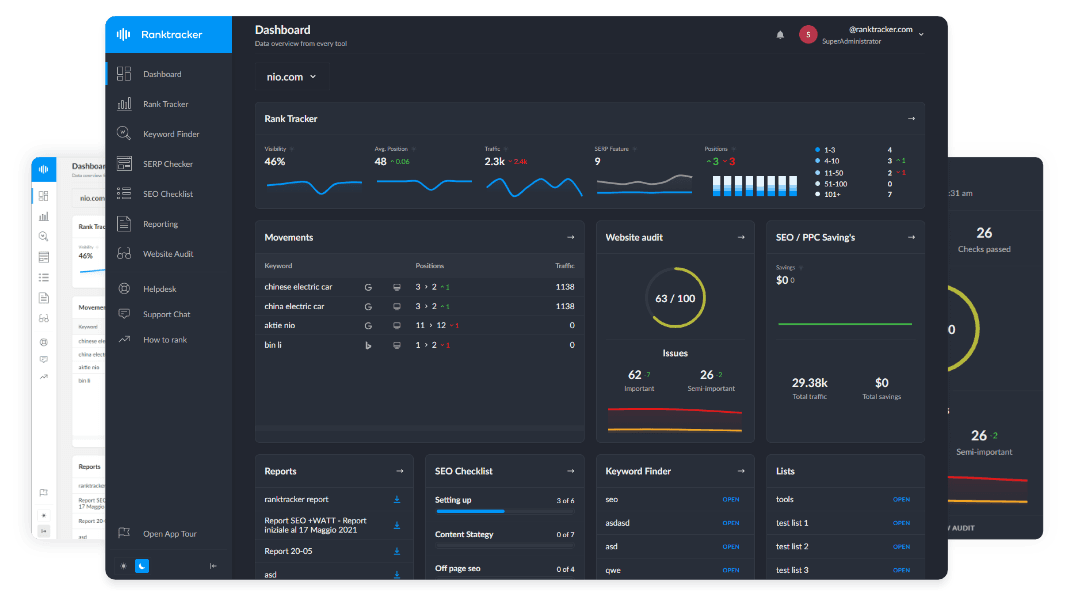Intro
Shoppers don’t just search for “shoes.” They look for “white leather sneakers size 10,” “best running shoes for flat feet,” or “vegan ankle boots under $100.” If your online shoe store isn’t optimized to capture these specific searches, you’re handing revenue to competitors. With the right SEO strategy, you can drive high-intent traffic, outperform marketplace giants, and build a brand that customers return to again and again.
Using Ranktracker’s full suite of SEO tools, you can uncover keyword opportunities, optimize your product listings, and track the performance that drives scalable success.
Why SEO Is Essential for Shoe Retailers
Shoes are a highly competitive e-commerce vertical. With so many styles, sizes, and brands, SEO allows you to appear exactly when a customer is looking for your specific offering—without burning cash on every click.
Benefits of SEO for online shoe stores:
-
Rank for specific, purchase-ready terms (e.g., “men’s waterproof hiking boots size 11”)
-
Build visibility for style, brand, and use-case keywords
-
Lower cost-per-sale by reducing dependency on paid ads
-
Capture evergreen traffic from recurring fashion trends and seasonal footwear needs
-
Build long-term brand equity and trust
Ranktracker’s Rank Tracker helps monitor how well your products, categories, and content perform in search engines compared to competitors.
Keyword Research: Target Buyer-Intent Across Shoe Types
Shoppers often search by brand, purpose, material, gender, occasion, or style. A successful SEO strategy taps into these search behaviors.
Use Ranktracker’s Keyword Finder to uncover:
-
Style and material terms: “white leather sneakers,” “black suede loafers”
-
Purpose-based queries: “best walking shoes for nurses,” “trail running shoes with arch support”
-
Occasion-based keywords: “wedding shoes for bride flat,” “men’s formal shoes under $100”
-
Brand and model: “Nike Air Force 1 low white,” “Dr. Martens 1460 Pascal”
-
Fashion trends: “chunky platform boots 2025,” “minimalist running shoes”
Target a mix of evergreen, seasonal, and trending terms across category, subcategory, and product pages.
Site Structure: Build for Crawlability and UX
An online shoe store should be organized for both users and search engines, reflecting shoe type, brand, style, and audience.
Optimal structure:
-
/collections/women-boots
-
/collections/mens-running-shoes
-
/collections/vegan-sneakers
-
/products/converse-chuck-70-hi-black
-
/products/nike-air-max-90-white-grey
-
/blog/how-to-choose-hiking-boots-for-winter
Use internal links between related products, category hubs, and style guides.
Ranktracker’s Web Audit identifies structural or navigational issues affecting SEO performance.
On-Page SEO: Optimize Product Pages to Rank and Convert
Each product page should be optimized for specific keywords that match how people shop for shoes.
The All-in-One Platform for Effective SEO
Behind every successful business is a strong SEO campaign. But with countless optimization tools and techniques out there to choose from, it can be hard to know where to start. Well, fear no more, cause I've got just the thing to help. Presenting the Ranktracker all-in-one platform for effective SEO
We have finally opened registration to Ranktracker absolutely free!
Create a free accountOr Sign in using your credentials
On-page SEO tips:
-
H1: include product name + style info (e.g., “Nike Air Max 90 – White & Grey Running Shoes”)
-
Meta title: include brand, style, purpose, and key modifier (e.g., “Nike Air Max 90 White Running Shoes for Men | Free Shipping”)
-
Description: write original content describing the material, fit, sizing, style, and use-case
-
Include alt text for all product photos: “Side view of Nike Air Max 90 in white and grey”
-
Add product schema markup for ratings, pricing, and availability
-
FAQs: address sizing, returns, comfort, and care instructions
Use Ranktracker’s SERP Simulator to test how your product pages appear in Google search results.
Category Page SEO: Capture Mid-Funnel Shoppers
Category pages are critical for SEO—they attract shoppers who know what they want, but not yet which product.
How to optimize:
-
Target keywords like “women’s waterproof boots,” “men’s leather dress shoes,” “kids back-to-school sneakers”
-
Use descriptive, keyword-rich category titles and H1s
-
Write intro copy with helpful guidance (e.g., “Explore our collection of men’s casual sneakers built for comfort and style.”)
-
Add filtering options for size, color, brand, price, and material
-
Include internal links to popular product pages and related content
Ranktracker’s Keyword Finder can help you build dozens of category landing pages based on search volume and intent.
Content Marketing: Attract and Educate Shoppers
SEO-focused content can bring in buyers during the research stage and push them toward the right product.
Content ideas:
-
“Top 10 Running Shoes for Flat Feet in 2025”
-
“The Best Vegan Shoe Brands You Need to Know”
-
“How to Break in Leather Boots Without Blisters”
-
“Sneaker Trends for Fall 2025”
-
“What’s the Difference Between Hiking Boots and Trail Runners?”
Ranktracker’s AI Article Writer allows you to scale content that matches your product focus and buyer personas.
Visual SEO: Make Product Imagery Search-Ready
Product images aren’t just for conversions—they also contribute to search visibility.
Best practices:
-
Filename: “adidas-ultraboost-23-white-grey.jpg”
-
Alt text: “Adidas Ultraboost 23 white and grey men’s running shoes side view”
-
Use multiple image angles (side, top, sole, lifestyle)
-
Include size guides and material close-ups
-
Optimize image size to improve page speed
Image-rich results in Google often drive traffic—especially for fashion and footwear.
Technical SEO: Create a Fast, Secure, Mobile-Optimized Store
The majority of shoe shoppers are mobile-first. Technical SEO ensures your store meets speed, security, and indexing standards.
Essentials:
-
Responsive mobile-first design
-
Fast page load speeds across product and category pages
-
Secure HTTPS checkout
-
Canonical URLs for variants (color, size) to avoid duplicate content
-
Structured data (Product, Review, Breadcrumb) for enhanced SERP results
-
Optimized XML sitemap and clean URL structure
Ranktracker’s Web Audit identifies slow-loading assets, crawl errors, and other technical issues.
Backlinks: Build Authority With Fashion & Lifestyle Media
Backlinks from trusted blogs, influencers, and magazines increase rankings and referral traffic.
Tactics:
-
Get featured in fashion roundups and “Top Shoes for…” lists
-
Reach out to style influencers or YouTubers for product reviews
-
Guest post on fashion, fitness, or sustainable lifestyle blogs
-
Collaborate with micro-influencers for evergreen blog content
-
Pitch product launches to fashion press and online retailers
Track your backlink profile growth with Ranktracker’s Backlink Checker and Backlink Monitor.
Reviews & Social Proof: Build Trust and Boost Rankings
Trust is key in footwear e-commerce—fit, quality, and return policies matter.
Use social proof to improve SEO and conversion:
-
Collect product reviews and enable review schema markup
-
Display average ratings and buyer feedback prominently
-
Encourage user-generated content (e.g., Instagram tags, customer photos)
-
Highlight press features, brand partnerships, and verified badges
-
Include FAQs to reduce friction in the buying process
Use Ranktracker’s Reputation Management tool to monitor brand sentiment and respond to customer feedback.
SEO Tracking and Growth
Measure, test, and refine. SEO results compound over time—but only if you monitor performance closely.
Track:
-
Keyword rankings for brand, category, and product keywords
-
Organic traffic to landing pages and blog content
-
Conversion rates by traffic source
-
Bounce rates, scroll depth, and engagement on key pages
-
Backlink profile quality and domain authority
-
Site speed and mobile usability
Use Ranktracker’s SEO Dashboard to visualize and act on all your data in one place.
Common SEO Mistakes for Shoe Stores
-
Copying manufacturer or distributor product descriptions
-
Ignoring category page content and relying on filters alone
-
Using generic alt text like “shoe.jpg”
-
Not optimizing for local or seasonal searches (e.g., “winter boots UK”)
-
Overlooking comparison or trend-based blog content
-
Missing internal links between collections, products, and blog posts
Online Shoe Store SEO Checklist
-
Product titles, meta tags, and descriptions optimized for keyword relevance
-
Category pages targeting style, material, occasion, and demographic queries
-
Blog content addressing style guides, fit advice, and fashion trends
-
Structured internal linking between blog, category, and product pages
-
Mobile-optimized and technically sound site architecture
-
Rich visuals with proper alt text and filenames
-
Reviews and UGC integrated into product pages
-
Backlink strategy targeting lifestyle and fashion media
-
SEO tracking using Ranktracker’s unified toolkit
Conclusion
The right SEO strategy can turn your online shoe store into a high-traffic, high-conversion business. With Ranktracker, you get access to the tools that uncover profitable keywords, optimize your site’s performance, and grow your visibility in one of e-commerce’s most competitive industries. Focus on structure, content, and trust—and let SEO drive your store forward.

